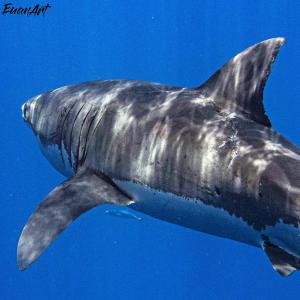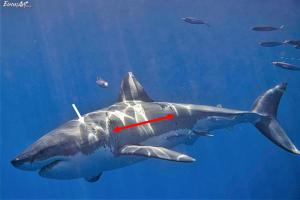World’s Largest Great White Shark May Be a Cannibal
Photos suggest there is a 28-foot great white out there that eats other sharks.
In 2019, marine photographer Euan Rannachan took underwater photos of a female great white shark known as Seabatch. Seabatch stood out to Euan because she had a huge bite scar on her left side, one that went from the front of her pectoral fin all the way to the back of her dorsal. The bite is gigantic – far too large to have been caused by a similar sized shark. But how big was it? And was the bite fresh or something that had simply “stretched” over the years?
The photographs were investigated by award-winning author and world-record-holding angler Max Hawthorne, whose #1 Amazon bestselling marine biology book Monsters & Marine Mysteries included investigations into multiple mega shark sightings. Hawthorne’s take on the photos was surprising.
“When I investigated evidence of giant sharks for Monsters & Marine Mysteries, I was dealing with bite widths that ranged from 27 to an astounding 48 inches. The numbers were shocking, and as I reviewed the assorted elasmobranch formulas for calculating overall length based on bites, I ended up going with the most conservative one available. That generated an estimated 26 feet in length for the Beast of Brier Island (bite marks on a humpback carcass measuring 27x37 inches) all the way to a potential 40+ foot animal that gouged a 4-foot-wide chunk out of a similar-sized whale shark (the Galapagos giant).”
Hawthorne added, “Despite earlier and erroneous reports that put Seabatch at 15 feet, Euan Rannachan told me she is “only” around 11 feet in length. He also gave me some terrific high-def images to work with, including a full broadside shot including the bite. Based on that evidence, I was able to calculate that the attacking shark was around 28 feet in length. We’re talking an enormous cow white shark with a bad attitude. Could it be the Brier Island shark? It’s possible. White sharks cover huge distances at times, and a 1,000+ mile swim isn’t out of the question. But this bite is a bit bigger, and was inflicted two years earlier.”
When asked about the possibility that the attack took place when Seabatch was younger and smaller and the bite scar grew with the shark, Hawthorne chuckled. “That’s a common misconception. People think that when a shark is bitten the bite magically grows with it and maintains not only its shape, but its symmetry as well. The truth is sharks are incredibly regenerative. Bites don’t stay the same. They fill in, smooth over, and in time all but disappear. I did a piece on this a few years back, showing a whale shark with white shark bites. The same bites were photographed around 14 months apart. At that point, you couldn’t even tell they were bites anymore.” Hawthorne continued. “In Seabatch’s case, not only is the bite a perfect and classical shark bite shape, you can see individual tooth rakes. I would bet this bite happened only a year or so earlier. It appears to have been deliberate, and from the angle, I believe it was an attempt at predation. This giant, older shark, which dwarfs the current world record great white, ‘Deep Blue’, by the way, tried to make a meal out of the younger one. Luckily, Seabatch’s speed and reflexes saved her. Otherwise, we wouldn’t have the photos to tell the tale.”
Kevin Sasaki
Media Representative
+1 310-650-3533
email us here
Monsters & Marine Mysteries by Max Hawthorne
Legal Disclaimer:
EIN Presswire provides this news content "as is" without warranty of any kind. We do not accept any responsibility or liability for the accuracy, content, images, videos, licenses, completeness, legality, or reliability of the information contained in this article. If you have any complaints or copyright issues related to this article, kindly contact the author above.



